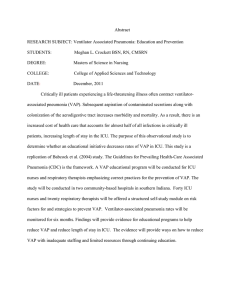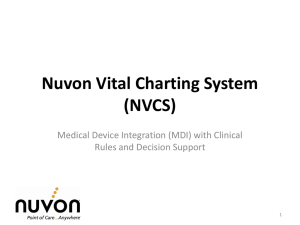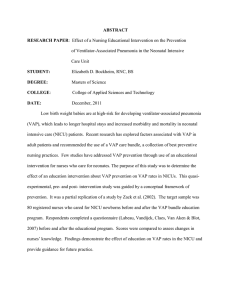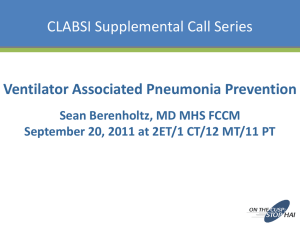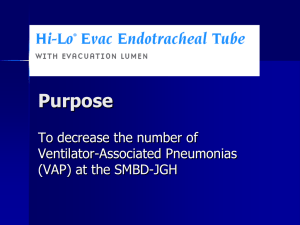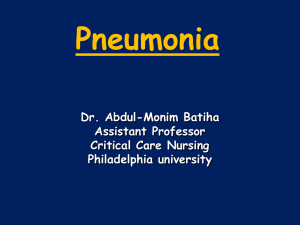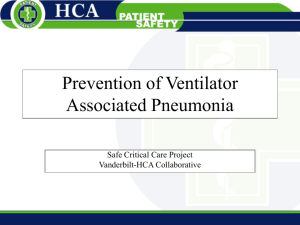Subglottic Secretion Drainage Fact Sheet
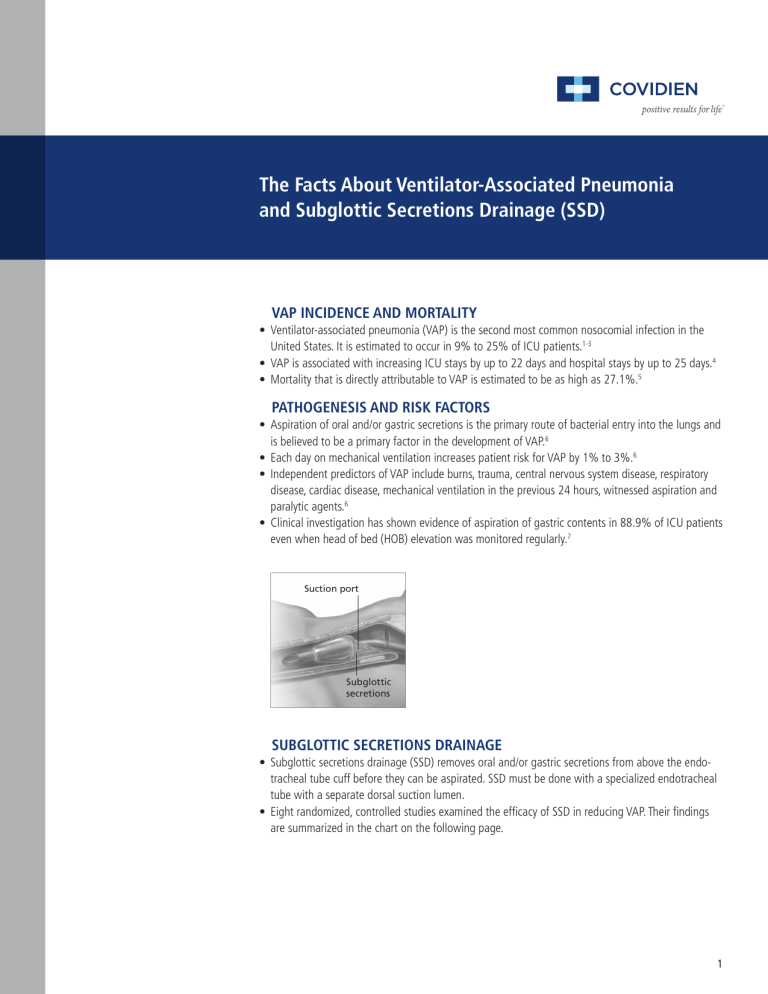
The Facts About Ventilator-Associated Pneumonia and Subglottic Secretions Drainage (SSD)
VAP INCIDENCE AND MORTALITY
• Ventilator-associated pneumonia (VAP) is the second most common nosocomial infection in the
United States. It is estimated to occur in 9% to 25% of ICU patients.
1-3
• VAP is associated with increasing ICU stays by up to 22 days and hospital stays by up to 25 days.
4
• Mortality that is directly attributable to VAP is estimated to be as high as 27.1%.
5
PATHOGENESIS AND RISK FACTORS
• Aspiration of oral and/or gastric secretions is the primary route of bacterial entry into the lungs and is believed to be a primary factor in the development of VAP.
6
• Each day on mechanical ventilation increases patient risk for VAP by 1% to 3%.
6
• Independent predictors of VAP include burns, trauma, central nervous system disease, respiratory disease, cardiac disease, mechanical ventilation in the previous 24 hours, witnessed aspiration and paralytic agents.
6
• Clinical investigation has shown evidence of aspiration of gastric contents in 88.9% of ICU patients even when head of bed (HOB) elevation was monitored regularly.
7
Suction port
Subglottic secretions
SUBGLOTTIC SECRETIONS DRAINAGE
• Subglottic secretions drainage (SSD) removes oral and/or gastric secretions from above the endotracheal tube cuff before they can be aspirated. SSD must be done with a specialized endotracheal tube with a separate dorsal suction lumen.
• Eight randomized, controlled studies examined the efficacy of SSD in reducing VAP. Their findings are summarized in the chart on the following page.
1
2
AUTHOR AND
PUBLISH DATE
Damas 2014
Hudson 2014
Tao 2014 10
Bouza 2008
Lorente 2007
15
17
Kollef 1999 18
8
13
9
> 48 hrs ventilation ventilation
PATIENT
PROFILE
ICU patients requiring mechanical ventilation for
Cardiac ICU patients requiring mechanical
ICU patients requiring mechanical ventilation
Perez Granda 2013 11 Cardiac ICU patients
Lacherade 2010
Liu 2006
14
Smulders 2002
Bo 2000
Valles 1995
Mahul 1992
19
20
12
16 requiring mechanical
ICU patients expected to require mechanical ventilation for >48 hours
Patients expected to be ventilated >48 Hours
Med/Surg ICU patients expected to be ventilated
>24 Hours
Patients expected to be ventilated >48 Hours
Surgical ICU patients expected to be ventilated >72 Hours
Surgical ICU patients expected to be ventilated >72 Hours
Cardio-thoracic patients
(average ventilation 1.5 Days)
Med/Surg ICU patients expected to be ventilated
>72 Hours
Med/Surg ICU patients expected to be ventilated
>72 Hours
Early-Onset
VAP (<4
Days) 3.6%
Late-Onset
VAP (>4
Days) 9.5%
6%
4%
23%
5%
18.4%
13%
PERCENT
VAP RATE
STUDY
8.8%
PERCENT VAP
RATE CONTROL
RELATIVE RISK
REDUCTION
17.6% 50%
ADDITIONAL OUTCOME
IMPROVEMENTS
1.9% 5.6% 66.1%
VAP INTERVENTIONS ALREADY
IN PLACE DURING STUDY
The CASS group had lower
30-day in-hospital mortality
(2.1% v 3.3%; p < 0.007), median ventilation time
(8.42 v 7.3 hours; p <
0.0001), and shorter median
ICU LOS (1.77 v 1.17 days; p
< 0.0004) compared to the control group.
• Semirecumbent position of at least
30°
• Oral care and teeth brushing with chlorhexidine 0.2%, followed by the application of 1% chlorhexidine gel
• Cuff pressure control of the endotracheal tube between 20 and
30 cm H
2
O
• Daily assessment of sedation
• Semirecumbent positioning
• Daily evaluation of readiness for extubation
• Oral care and decontamination with chlorhexidine
• Initiation of safe enteral nutrition within 24 to 48 hours of ICU admission
13% 40.4% 67.8%
16.46%
14.8%
26.7%
23.92%
25.6%
47.5%
10.7%
26.7%
31.2%
42.2%
44%
66%
64%
The Mallinckrodt ™
TaperGuard ™ Evac ETT group had a decreased cost of antimicrobials, €71,384 vs €63,446 (P < 0.002); and days of mechanical ventilation, 507.5 vs 377.5
(P < 0.009) compared to the control group.
In patients intubated >48 hours, use of CASS reduced
ICU length of stay by 9.5 days, and reduced duration of mechanical ventilation by 4 days.
Hospital antibiotic use in daily defined doses (DDD) was less in the CASS group:
(1213 vs 1932, P<.001, and
1392 vs 1932, P<.001)
• Enteral delivery of nutritional support
• Cuff pressure maintained between
20 and 30 cm H O
2
• Semirecumbent body position
• All patients received stress ulcer prophylaxis.
• In patients intubated >48 hours, all patients but one were maintained in a semirecumbent position when possible
• Semirecumbent body position of 40 degrees
• Periodic verification every 4 hours of intracuff pressure of 25 cm H
8 hours
2
O
• Oral care with chlorhexidine every
20%
6%
45%
8.2%
32.5%
29%
70%
75%
49%
Not statistically significant
43%
55%
• All patients received stress ulcer prophylaxis with sucralfate
• Stress ulcer prophylaxis
3
DEFINING EARLY- VERSUS LATE-ONSET VAP
• Early-onset VAP is defined as a VAP occurring <4 days following initial intubation.
• Late-onset VAP is defined as a VAP occurring ≥4 days following initial intubation.
21
• Late-onset VAP is often associated with high-risk pathogens such as MRSA and is associated with a greater negative impact on patient outcomes and hospital cost.
22
IN PATIENTS VENTILATED >5 DAYS
Hospital stay (days)
Duration of mechanical ventilation (days)
WITHOUT
VAP
29.1
18
LATE-ONSET VAP 18
42.7
18
12.6
18 25 18
COST
• VAP is associated with an increased, incremental cost of
$40,000.
4
• Late-onset VAP is associated with $60,000 in incremental cost to the hospital.
4
OUTCOME IMPROVEMENTS WITH SSD
Clinical investigation by Bouza et al found a significant improvement in patient outcomes with the use of an endotracheal tube providing subglottic secretion drainage, including:
• Reduced antibiotic use in the overall patient population by 30%.
• Reduced ICU length of stay by 9.5 days.
• Shortened duration of mechanical ventilation by 4 days.
13
Clinical outcome in patients receiving mechanical ventilation for >48 h
P=0.04
RR, 0.40
26.7
47.5
VAP
P=0.03
51.6
P<0.001 P=0.02 P=0.01 P=0.3
44.4
52.5
31.5
1206.5
1877.5
Episodes of
VAP/1,000 day of MV, N0.
Antibiotic usage
16.5
3
3 7
Duration of
MC, day
Length of
ICU stay, day
Mortality
SSD Control
Based on data from table 6 in Bouza et al 9
A meta-analysis by Dezfulian et al of five studies found that in patients expected to be ventilated >72 hours, aspiration of subglottic secretions decreased ICU length of stay, decreased duration of mechanical ventilation and delayed the onset of VAP by
6.9 days.
23
AMERICAN THORACIC SOCIETY/
INFECTIOUS DISEASES SOCIETY OF AMERICA EVIDENCE LEVELS
EVIDENCE LEVEL DEFINITION
Level I (high) Evidence comes from well-conducted, randomized controlled trials.
Level II (moderate)
Level III (low)
Evidence comes from well-designed, controlled trials without randomization or large case series with systematic analysis of disease patterns and/or microbial etiology.
Evidence comes from case studies and expert opinion.
CENTERS FOR DISEASE CONTROL AND PREVENTION GUIDELINES
Category IA Strongly recommended for implementation and strongly supported by well-designed experimental, clinical or epidemiologic studies.
Category IB
Category IC
Category II
No Recommendation;
Unresolved
Strongly recommended for implementation and supported by some clinical or epidemiologic studies and by strong theoretical rationale.
Required for implementation, as mandated by federal or state regulation or standard.
Required for implementation, as mandated by federal or state regulation or standard.
Practices for which insufficient issue evidence or no consensus exists about efficacy.
PREVENTION OF VENTILATOR-ASSOCIATED PNEUMONIA
Summary of Published Guidelines
Guidelines can be a valuable evidence-based resource for facilities seeking to improve their practices to reduce ventilator-associated pneumonia (VAP). Following is a summary of selected guidelines, recommendations, bundles and practice alerts for the prevention of healthcare-associated or ventilator-associated pneumonia. This summary includes guidelines from the American Thoracic Society
(ATS) and Infectious Diseases Society of America (IDSA), 21 the
Centers for Disease Control and Prevention (CDC), 24 the Canadian
Critical Care Society (CCCS), 25 the Agency for Healthcare Research and Quality (AHRQ), 26 the Institute for Healthcare Improvement
(IHI), 27 the American Association of Critical Care Nurses (AACN), 28
Safer Healthcare Now (SHN)25 and the Society for Healthcare
Epidemiology of America (SHEA/IDSA).
30
For the complete recommendations and supporting documentation from each organization, please refer to the published guideline or document.
AACN SHN
SHEA/
IDSA INTERVENTION
Staff education and involvement
Appropriate hand disinfection
Surveillance of ICU infections
Avoid intubation and reintubation when possible
Noninvasive ventilation when possible
Oral vs. nasal intubation and gastric tube placement
Continuous aspiration of subglottic secretions
Maintain endotracheal cuff pressures >20 cm H
2
0
Prevent circuit condensate from entering
ET tube or nebulizers
Adequate staffing levels in ICU
Semi-recumbent positioning
Enteral vs. parenteral nutrition
Routine use of selective digestive decontamination
ATS/IDSA
I
II
I
II
II
II
I
I
I
CDC
IA
IA
IB
II
II
IB
II
IB
CCCS
(Consider)
AHRQ
Routine use of oral chlorhexidine
I
II
I
Not recommended
Not recommended
II
Unresolved
Unresolved
Unresolved
Daily interruption or lightening of sedation
Stress bleeding prophylaxis with either H
2 antagonists or sucralfate
Change ventilator circuits only when visibly soiled; no regular changes
Use of heat and moisture exchangers
(HMEs)
Recommendation for closed suction or single-use open suction
Kinetic beds
Oral hygiene program for high-risk patients
Tight glycemic control
Deep vein thrombosis (DVT) prophylaxis
Avoid gastric over-distention
II
Either
Unresolved
No preference
I
Preference unresolved
IA
Unresolved
Closed suction
II
Sucralfate not recommended
(Consider)
ATS/IDSA evidence levels and CDC guideline categories are defined on previous page. = Included in organization’s recommended practices.
H
2 antagonists
IHI
4
6135 Gunbarrel Avenue
Boulder, CO 80301
800-635-5267 covidien.com/rms
Reference(s)
1. Ibrahim EH, Tracy L, Hill C, Fraser VJ, Kollef MH. The occurrence of ventilator-associated pneumonia in a community hospital: risk factors and clinical outcomes. Chest. 2001;120(2):555-561.
2. Craven DE, Steger KA. Nosocomial pneumonia in mechanically ventilated adult patients: epidemiology and prevention in 1996. Semin Respir Infect. 1996;11(1):32-53.
3. Rello J, Ollendorf DA, Oster G, et al. Epidemiology and outcomes of ventilator-associated pneumonia in a large US database. Chest. 2002;122(6):2115-2121.
4. Warren DK, Shukla SJ, Olsen MA, et al. Outcome and attributable cost of ventilator-associated pneumonia among intensive care unit patients in a suburban medical center. Crit Care Med. 2003;31(5):1312-1317.
5. Fagon JY, Chastre J, Hance AJ, Montravers P, Novara A, Gibert C. Nosocomial pneumonia in ventilated patients: a cohort study evaluating attributable mortality and hospital stay. Am J Med. 1993;94(3):281-288.
6. Cook DJ, Walter SD, Cook RJ, et al. Incidence of and risk factors for ventilator-associated pneumonia in critically ill patients. Ann Intern Med. 1998;129(6):433-440.
7. Metheny NA, Clouse RE, Chang YH, Stewart BJ, Oliver DA, Kollef MH. Tracheobronchial aspiration of gastric contents in critically ill tube-fed patients: frequency, outcomes, and risk factors. Crit Care Med. 2006;34(4):1007-1015.
8. Damas P, Frippiat F, Ancion A, et al. Prevention of ventilator-associated pneumonia and ventilator-associated conditions: a randomized controlled trial with subglottic secretion suctioning. Crit Care Med. 2015;43(1):22-30.
9. Hudson JK, Mcdonald BJ, Macdonald JC, Ruel MA, Hudson CC. Impact of subglottic suctioning on the incidence of pneumonia after cardiac surgery: a retrospective observational study. J Cardiothorac Vasc Anesth. 2015;29(1):59-63.
10. Tao Z, Zhao S, Yang G, Wang L, Zhu S. [Effect of two methods of subglottic secretion drainage on the incidence of ventilator-associated pneumonia]. Zhonghua Jie He He Hu Xi Za Zhi. 2014;37(4):283-6.
11. Pérez granda MJ, Barrio JM, Hortal J, Muñoz P, Rincón C, Bouza E. Routine aspiration of subglottic secretions after major heart surgery: impact on the incidence of ventilator-associated pneumonia. J Hosp Infect. 2013;85(4):312-5.
12. Lacherade JC, De Jonghe B, Guezennec P, et al. Intermittent subglottic secretion drainage and ventilator-associated pneumonia: a multicenter trial. Am J Respir Crit Care Med. June 3, 2010. Am J Respir Crit Care Med.
2010;182(7):910-917.
13. Bouza E, Pérez MJ, Muñoz P, Rincón C, Barrio JM, Hortal J. Continuous aspiration of subglottic secretions in the prevention of ventilator-associated pneumonia in the postoperative period of major heart surgery. Chest. 2008;
134(5):938-946.
14. Lorente L, Lecuona M, Jiménez A, Mora ML, Sierra A. Influence of an endotracheal tube with polyurethane cuff and subglotic secretion drainage on pneumonia. Am J Respir Crit Care Med. 2007;176(11):1079-1183.
15. Liu SH, Yan XX, Cao SQ, An SC, Zhang LJ. The effect of subglottic secretion drainage on prevention of ventilator-associated lower airway infection. Zhonghua Jie He He Hu Xi Za Zhi. 2006;29(1):19-22.
16. Smulders K, van der Hoeven H, Weers-Pothoff I, Vandenbroucke-Grauls C. A randomized clinical trial of intermittent subglottic secretion drainage in patients receiving mechanical ventilation. Chest. 2002;121(3):858-862.
17. Bo H, He L, Qu J. Influence of the subglottic secretion drainage on the morbidity of ventilator associated pneumonia in mechanically ventilated patients. Zhonghua Jie He He Hu Xi Za Zhi. 2000;23(8):472-474.
18. Kollef MH, Skubas NJ, Sundt TM. A randomized clinical trial of continuous aspiration of subglottic secretions in cardiac surgery patients. Chest. 1999;116 (5):1339-1346.
19. Vallés J, Artigas A, Rello J, et al. Continuous aspiration of subglottic secretions in preventing ventilator-associated pneumonia. Ann Intern Med. 1995;122 (3):179-186.
20. Mahul P, Auboyer C, Jospe R, et al. Prevention of nosocomial pneumonia in intubated patients: respective role of mechanical subglottic secretions drainage and stress ulcer prophylaxis. Intensive Care Med. 1992;18(1):20-25.
21. American Thoracic Society; Infectious Diseases Society of America. Guidelines for the management of adults with hospital-acquired, ventilator-associated, and healthcare-associated pneumonia. Am J Respir Crit Care Med.
2005;171(4):388-416.
22. Kollef MH, Silver P, Murphy DM, Trovillion E. The effect of late-onset ventilator-associated pneumonia in determining patient mortality. Chest. 1995;108(6):1655-1662.
23. Dezfulian C, Shojania K, Collard HR, Kim HM, Matthay MA, Saint S. Subglottic secretion drainage for preventing ventilator-associated pneumonia: a metaanalysis. Am J Med. 2005;118(1):11-18.
24. Tablan OC., Anderson, LJ, Besser R, Bridges C , Hajjeh R. Guidelines for Preventing Health-Care-Associated
Pneumonia, 2003, Recommendations of CDC and the Healthcare Infection Control Practices Advisory Committee.
2004; 53(RR03), 1-36. Available at: http://www.cdc.gov/mmwr/preview/mmwrhtml/rr5303a1.htm.
25. Dodek P, Keenan S, Cook D, et al; Canadian Critical Care Trials Group; Canadian Critical Care Society. Evidence-based clinical practice guideline for the prevention of ventilator-associated pneumonia. Ann Intern Med. 2004;141(4):
305-313.
26. Shojania KG, Duncan BW, McDonald KM, Wachter RM, Markowitz AJ. Making health care safer: a critical analysis of patient safety practices. Evid Rep Technol Assess (Summ). 2001;(43):i-x, 1-668.
27. Prevent Ventilator-Associated Pneumonia. Institute for Healthcare Improvement. 100,000 Lives Campaign. http://www.ihi.org/IHI/Programs/Campaign/VAP.htm.
28. American Association of Critical Care Nurses. Practice Alert: Ventilator Associated Pneumonia. January 2008. http://www.aacn.org/WD/Practice/Docs/Ventilator_Associated_Pneumonia_1-2008.pdf.
29. Safer Healthcare Now! Campaign April 2009 How-to Guide: Prevention of VAP. http://www.saferhealthcarenow.ca/
EN/Interventions/VAP/Pages/default.aspx.
30. Yokoe DS, Mermel LA, Anderson DJ, et al. A compendium of strategies to prevent healthcare-associated infections in acute care hospitals. Infect Control Hosp Epidemiol. 2008;29 Suppl 1:S12-21.
COVIDIEN, COVIDIEN with logo, Covidien logo and positive results for life are U.S. and internationally registered trademarks of Covidien AG. ©2009, 2011, 2015 Covidien. 15-AW-0004
